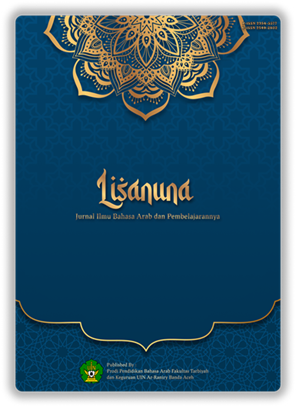في مهارة الاستماع لدى طلاب الفصل الثامن في مدرسة التريبة الإسلامية جندونج آغم "Animasi" تأثير استخدام وسيلة الرسوم المتحركة
DOI:
https://doi.org/10.22373/ls.v14i2.28056Keywords:
Animation Media, Listening skillsAbstract
This research aims to determine the effect of using animation media in Arabic language learning to improve students' listening skills at Madrasah Tarbiyah Islamiyah Candung Agam. This research uses a qualitative approach with experimental methods. Data collection techniques through test questions. A qualitative approach was chosen to provide an in-depth understanding of the experiences and views of teachers and students regarding the application of animated learning media. This research involved several steps. First, through the observation stage, the researcher actively observed and recorded how animation media was applied in Arabic language learning at the Candung Agam Islamic Tarbiyah Madrasah. and Interaction between teachers and students as well as students' responses to this learning media are the main focus of observation. Second, test questions were carried out on students to determine the extent of their improvement and understanding regarding the use of animation media. Based on data analysis, this research concludes that the use of animation-based learning media provides significant benefits in improving students' Arabic listening skills at Madrasah Tarbiyah Islamiyah Canduang Agam. Through this learning media, teachers can present learning material in a more interesting and interactive way, which directly attracts students' interest and attention. Apart from that, the use of animation media also increases students' motivation in learning and listening to Arabic.
References
Furoidah, Asni, ‘Media Pembelajaran Dan Peran Pentingnya Dalam Pengajaran Dan Pembelajaran Bahasa Arab’, Al-Fusha : Arabic Language Education Journal, 2.2 (2020), 63–77
Fajar, Andika Putra, Alfian Candra Ayuswantana, and Sri Wulandari, ‘Video Animasi Untuk Menghadapi Masalah Kesehatan Mental Pada Remaja’, Jurnal Imajinasi, 7.2 (2023), 176
Halimatus sa’diah, ‘pengaruh penggunaan media animasi audio visual terhadap keterampilan menyimak cerita anak pada kelas v MI AL-HIKMAH’,2017.
Inesri, Afrinaldi, Salmi Wati, Yelfi Dewi, ‘Peran Guru Mewujudkan Akhlakul Karimah Pada Siswa Dalam Pembelajaran Al_Qur’an Di Madrasah Diniyah Takmiyah Awaliyah Tarok Kota Bukittinggi’, Jurnal Pendidikan Dan Konseling, 5.1 (2023), 2921
Kumar, T. M. Vinod, ‘Efektifitas Penggunaan Media Audio Visual Dalam Meningkatkan Kemampuan Berbahasa Arab Peserta Didik Kelas XI Mipa Madrasah Aliyah Di Kanang Kab. Polman’, Journal of Chemical Information and Modeling, 53.9 (2019), 1689–99
Muhammad Fathoni, ‘Maharah Istima ’’, Jurnal Komunikasi Dan Pendidikan Islam, 1 (2018), 2020 Nasution, Novita Sari, and Lahmuddin Lubis, ‘Urgensi Pembelajaran Bahasa Arab Dalam Pendidikan Islam’, Jurnal Simki Pedagogia, 6.1 (2023), 181–91
Nurul Dewi Asriani, ‘Efektivitas Penggunaan Media Animasi Terhadap Penguasaan Mufrodat Siswa Kelas VII MTS Ma’arif NU 2 Cilongok Tahun Pelajaran 2020/2021’, 2022
Ramdani, Dinda, and Eka Rizal, ‘تأثير استخدام لعبة Educaplay في تعليم مهارة الاستماع في مدرسة الابتدائية الإسلامية الشيخ محمد جميل جمبيك بوكت تنجي’, 2022
Safitri, Anna, ‘Pemanfaatan Video Animasi Youtube Sebagai Media Pembelajaran Maharah Istima’ Bahasa Arab Di SMP IT BQN Mataram’, Journal.Ummat.Ac.Id, 1.1 (2022), 14–22
SukContoh BIssa JTabarearno, Nurul Mutiani, Panji Wisnu Wirawan, Satriyo Adhy, Sukses Andi, Hafid Mukhlasin, Muhaemin Muhaemin, and others, ‘Penerapan Media Animasi Dalam Meningkatkan Bahasa Anak Pada Usia 5-6 Tahun Di Taman Kanak-Kanak Bela Bangsa Mandiri Tanjung Senang Bandar Lampung’, Rabit : Jurnal Teknologi Dan Sistem Informasi Univrab, 1.1 (2019), 2019
Sunandar, Berlian, ‘Penggunaan Media Video Animasi Dalam Pembelajaran Pendidikan Agama Islam Kelas Viii Di Smp Qur’an Nurul Huda Pesawaran’, Nursing Scientific Journal, 3.2 (2020), 19
Sugiono, Metode Penelitian Pendidikan: Pendekatan kuantitatif dan R&D.6 th ed.(Bandung: Alfabeta, 2008).
Prananingrum, Afiffah Vinda, Ikhwan Nur Rois, and Anna Sholikhah, ‘Kajian Teoritis Media Pembelajaran Bahasa Arab’, Konferensi Nasonal Bahasa Arab (KONASBARA), 3.1 (2020), 303–19
Downloads
Published
Issue
Section
License
1. Proposed Policy for Journals That Offer Open Access Authors who publish with this journal agree to the following terms:
1.a. Authors retain copyright and grant the journal right of first publication with the work simultaneously licensed under a Creative Commons Attribution License that allows others to share the work with an acknowledgement of the work's authorship and initial publication in this journal.
1.b. Authors are able to enter into separate, additional contractual arrangements for the non-exclusive distribution of the journal's published version of the work (e.g., post it to an institutional repository or publish it in a book), with an acknowledgement of its initial publication in this journal.
1.c. Authors are permitted and encouraged to post their work online (e.g., in institutional repositories or on their website) prior to and during the submission process, as it can lead to productive exchanges, as well as earlier and greater citation of published work (See The Effect of Open Access).
2. Proposed Policy for Journals That Offer Delayed Open Access Authors who publish with this journal agree to the following terms:
2.a. Authors retain copyright and grant the journal right of first publication, with the work [SPECIFY PERIOD OF TIME] after publication simultaneously licensed under a Creative Commons Attribution License that allows others to share the work with an acknowledgement of the work's authorship and initial publication in this journal.
2.b. Authors are able to enter into separate, additional contractual arrangements for the non-exclusive distribution of the journal's published version of the work (e.g., post it to an institutional repository or publish it in a book), with an acknowledgement of its initial publication in this journal.
2.c. Authors are permitted and encouraged to post their work online (e.g., in institutional repositories or on their website) prior to and during the submission process, as it can lead to productive exchanges, as well as earlier and greater citation of published work (See The Effect of Open Access).

